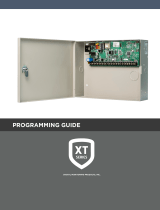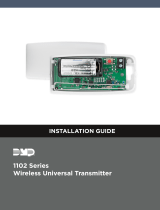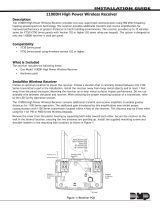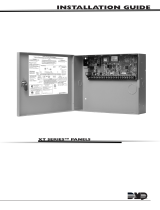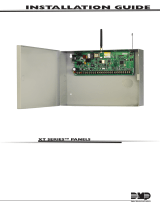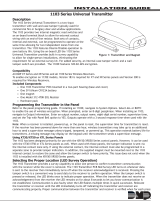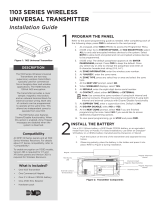Page is loading ...

1100DH SERIES HIGH POWER
WIRELESS RECEIVERS
Installation Guide
Figure 1: 1100DH High Power
Wireless Receiver
R Y G B TO PANEL
The 1100DH Series Wireless Receiver
provides up to 32 wireless zones for
XT30/XT50 Series panels. The 1100DHE
features 128-bit AES encryption.
The 1100DH Series provides two-way,
supervised communication using
900 MHz frequency hopping spread
spectrum technology.
The 1100DH contains additional transmit
and receive amplifiers to enable greater
distances for 1100 Series operation for
harsh building environments.
The system is designed so only one
1100DH is used per panel.
Compatibility
• XT30 Series panels
• XT50 Series panels running
firmware Version 102 or higher
• Encryption requires panel
Version183 or higher
• 1100T Translator requires receiver
firmware Version 207/301 and
higher
What is Included?
• One 1100DH Wireless Receiver
• Hardware Pack
1PROGRAM THE PANEL
Refer to the panel programming guide as needed.
1. Reset the panel.
2. At a keypad, enter 6653 (PROG) to access the
PROGRAMMER menu.
3. In SYSTEM OPTIONS, program a HOUSE CODE
between 1 and 50. See House Code Explained for more
information.
4. If you are programming an XT50 Series panel, select NO
at the BUILT IN 1100 WIRELESS prompt to allow the
panel to use the 1100DH for wireless communication.
5. (1100DHE only) At the 1100 ENCRYPTION prompt,
select ALL to only add encrypted wireless devices to
the system. Select BOTH to allow both encyrpted and
non-encrypted wireless devices to be programmed.
6. (1100DHE only) The default passphrase appears at
the ENTER PASSPHRASE prompt. Press CMD to keep
the default. Press any select key or area to change the
passphrase and enter an 8-character hexidecimal string
(0-9, A-F).
7. Press CMD until STOP displays and press a select key or
area to save and exit the Programmer.
DESCRIPTION
SELECT A LOCATION
2The receiver should be centrally located between the DMP panel
and the 1100 Series transmitters used in the installation based
on the wiring specifications below. Use an 1106 Series Universal
Wireless Transmitter to perform an LED survey.
1. With the cover removed, hold the transmitter in the
desired location.
2. Press the tamper switch to send data to the panel and
determine if communication is confirmed or faulty.
Confirmed: If communication is confirmed, for each
press or release of the tamper switch, the LED blinks
immediately on and immediately off.
Faulty: If communication is faulty, the LED remains on
for about 8 seconds or flashes multiple times in quick
succession. Relocate the receiver until the LED confirms
clear communication.

2 1100DH SERIES INSTALLATION GUIDE | DIGITAL MONITORING PRODUCTS
ADDITIONAL INFORMATION
Black
Green
Yellow
Red
J4
RED PRO
J8
XT30/XT50 Series Panel
J7
RJ SUP
AC
1234 5 6 7 810 11 12
9
+B BELL GND SMK
RED YEL GRN BLK
AC -B
1100DH
Receiver
PANEL
Can be extended from
the panel up to 500 ft
using 22 AWG or 1,000
ft using 18 AWG
Figure 2: Wiring the 1100DH to the Panel
Mounting Holes
3The panel immediately recognizes the 1100DH if the panel is programmed with a house code. Do not use
shielded wire between the panel and receiver.
1. Connect the red, yellow, green, and black wires to the PANEL terminal on the 1100DH.
2. Connect the other end of the wires to the terminals 7, 8, 9, and 10 on the panel. See Figure 2
3. Use the included #6 screws to secure the 1100DH to the wall. See Figure 2 for mounting hole locations.
4. Snap the cover back on to the base.
WIRE AND MOUNT THE RECEIVER
Table 1: Zone Number Designations
DMP PANEL AVAILABLE ZONES ZONE RANGES
XT50 with built-in receiver 48 11 - 14, 21 - 24, 31 - 34, 41 - 44, 51 - 54, 61 - 64, 71 - 74, 81 - 84, 80, 85 - 99
XT30 and XT50 (1100D Series) 32 11 - 14, 21 - 24, 31 - 34, 41 - 44, 51 - 54, 61 - 64, 71 - 74, 81 - 84
Wiring Specifications for Keypad Bus
1. DMP recommends using 18 or 22-gauge unshielded wire for all keypad and LX-Bus circuits. Do Not use twisted pair
or shielded wire for LX-Bus and Keypad Bus data circuits. To maintain auxiliary power integrity when using 22-gauge
wire do not exceed 500 feet. When using 18-gauge wire do not exceed 1,000 feet. Install an additional power supply
to increase the wire length or add devices.
2. Maximum distance for any one circuit (length of wire) is 2,500 feet regardless of the wire gauge. This distance can
be in the form of one long wire run or multiple branches with all wiring totaling no more than 2,500 feet. As wire
distance from the panel increases, DC voltage on the wire decreases.
3. Maximum number of devices per 2,500 feet circuit is 40.
4. Maximum voltage drop between the panel (or auxiliary power supply) and any device is 2.0VDC. If the voltage at
any device is less than the required level, add an auxiliary power supply at the end of the circuit. When voltage is
too low, the devices cannot operate properly. Refer to the panel installation guide and LX-Bus/Keypad Bus Wiring
Application Note (LT-2031).
Programming Zones
Refer to the panel XT30/XT50 Series Programming Guide (LT-0981) for complete wireless programming information.
When any wireless input zone for a particular address is programmed, the 1100DH responds to the panel for this address.
Other devices, such as keypads or hardwired zone expanders, cannot use this address. Zones connected directly to the
panel cannot be wireless. See Table 1 for designated zone numbers.

1100DH SERIES INSTALLATION GUIDE | DIGITAL MONITORING PRODUCTS 3
Transmitter Supervision TIme
For listed installations, program the transmitter supervision time in panel zone programming as listed in the following
table. Refer to the panel programming guide for complete wireless programming information.
LED INDICATIONS
RF RX Flashing yellow indicates
data is being received from a
transmitter.
RF TX Flashing green indicates data is
being sent to a transmitter.
PANEL RX Flashing yellow indicates data
is being received from a panel.
PANEL TX Flashing green indicates data is
being sent to the panel.
STATUS Solid red indicates memory is
being uploaded. Turns off when
complete.
PWR Solid green indicates there is
power to the wireless receiver.
Table 2: LED Indications
UL Listing Listed Accessories Supervision Time
UL 268 Smoke-Automatic Fire Detectors
1164 Synchronized Smoke Detector
1164NS Smoke Detector with No Sounder
1168 Wireless Smoke/CO/Low Temp Detector
3
UL 365 Police Station Connected Burglar Accessory 1103 Universal Transmitter 60
UL 521 Heat Detectors for Fire Protective Signaling
Systems 1183-135F, 1183-135R Heat Detectors 3
UL 609 Local Burglar Alarm Units and System
Accessory 1103 Universal Transmitter 60
UL 634 Connections and Switches for use with
Burglar Alarm Systems Accessory 1101, 1102, 1103, 1106 Universal Transmitters 60
UL 636 Holdup Alarm Units and Systems Accessory 1142 Two-Button Holdup Transmitter 60
UL 639 Intrusion Detection Units Accessory 1127W, 1127C PIR Motion Detectors 60
UL 985 Household Fire Warning System Accessory 1135 Siren
9060, 9063, 9862 Keypads 240
UL 1023 Household Burglary System Units Accessory
1101, 1102, 1103, 1106 Universal Transmitters
1127W, 1127C PIR Motion Detectors
1135 Siren
1142 Two-Button Holdup Transmitter
9060, 9063, 9862 Keypads
60
UL 1076 Proprietary Burglar Alarm Units Accessory 1103 Universal Transmitter 60
UL 1610 Central Station Burglar Alarm Units Accessory
1103 Universal Transmitter
1135 Siren
9060, 9063, 9862 Keypads
60
UL 2075 Gas and Vapor Detectors and Sensors 1168 Wireless Smoke/CO/Low Temp Detector
1184 Wireless Carbon Monoxide Detector 240
Table 3: Wireless Transmitter Supervision Times
1100DH LED Operation
The six labeled LEDs on the 1100DH PCB display wireless receiver operation
and activity. See Figure 2 for LED locations and Table 2 for LED indications.
House Code Explained
The house code identifies the panel, receiver, and transmitters to each
other. The 1100DH automatically sends the specified house code to wireless
transmitters when transmitter serial numbers are programmed into the
panel.
The 1100DH only listens for transmissions using the specified house code or
the programmed transmitters’ serial numbers.
Note: The 1100R Wireless Repeater and 1100T Wireless Translator follow the Receiver Supervision times for Listed
Accessories.
Note: The status LED light will remain solid red when wireless
jamming is enabled or if there is a large amount of RF activity in
the vicinity of the receiver.

INTRUSION • FIRE • ACCESS • NETWORKS
2500 North Partnership Boulevard
Springfield, Missouri 65803-8877
800.641.4282 | DMP.com
Designed, engineered, and
manufactured in Springfield, MO
using U.S. and global components.
LT-1821 1.01 21062
©2021
Certifications
California State Fire Marshal (CSFM)
FCC Part 15 Registration ID: CCKPC0114R6
CCKPC0114R9
Industry Canada: 5251A-PC0114R6
5251A-PC0114R9
Intertek (ETL) Listed
• ANSI/UL 365 Police Station Connected Burglar
• ANSI/UL 609 Local Burglar Alarm Units & Systems
• ANSI/UL 985 Household Fire Warning Systems
• ANSI/UL 1023 Household Burglar Alarm System Units
• ANSI/UL 1076 Proprietary Burglar Alarm Units
• ANSI/UL 1610 Central Station Burglar Alarm Units
Compatible With Devices Listed for:
• ANSI/UL 268 Smoke Detectors for Fire Alarm Signaling Systems
• ANSI/UL 521 Heat Detectors for Fire Protective Signaling Systems
• ANSI/UL 634 Connections and Switches for use with Burglar
Alarm Systems Accessory
• ANSI/UL 636 Safety Holdup Alarm Units and Systems
• ANSI/UL 639 Intrusion Detections Units Accessory
• ANSI/UL 2075 Gas and Vapor Detectors and Sensors
1100DH HIGH POWER
WIRELESS RECEIVERS
Specifications
Operating Voltage 12VDC Nominal
Current Draw 75 mA (average), 102 mA (peak)
Frequency Range 905-924MHz
Housing Dimensions 5.5” W x 3.75” L x 1” H
Housing Color White
Housing Material Flame Retardant ABS
Patents
U. S. Patent No. 7,239,236
Ordering Information
1100DH-W Standard High Power Wireless Receiver
1100DHE-W Encrypted High Power Wireless Receiver
FCC INFORMATION
This device complies with Part 15 of the FCC Rules. Operation is subject to the following two conditions:
1. This device may not cause harmful interference, and
2. this device must accept any interference received, including interference that may cause undesired operation.
The antenna used for this transmitter must be installed to provide a separation distance of at least 20 cm (7.874 in.) from all persons. It must not be located or operated in
conjunction with any other antenna or transmitter.
Changes or modifications made by the user and not expressly approved by the party responsible for compliance could void the user’s authority to operate the equipment.
Note: This equipment has been tested and found to comply with the limits for a Class B digital device, pursuant to part 15 of the FCC Rules. These limits are designed to
provide reasonable protection against harmful interference in a residential installation. This equipment generates, uses and can radiate radio frequency energy and, if not
installed and used in accordance with the instructions, may cause harmful interference to radio communications. However, there is no guarantee that interference will not
occur in a particular installation. If this equipment does cause harmful interference to radio or television reception, which can be determined by turning the equipment off and
on, the user is encouraged to try to correct the interference by one or more of the following measures:
1. Reorient or relocate the receiving antenna.
2. Increase the separation between the equipment and receiver.
3. Connect the equipment into an outlet on a circuit dierent from that to which the receiver is connected.
4. Consult the dealer or an experienced radio/TV technician for help.
Industry Canada Information
This device complies with Industry Canada Licence-exempt RSS standard(s). Subject to the following two conditions:
1. This device may not cause interference, and
2. this device must accept any interference, including interference that may cause undesired operation of the device.
This system has been evaluated for RF Exposure per RSS-102 and is in compliance with the limits specified by Health Canada Safety Code 6. The system must be installed at a
minimum separation distance from the antenna to a general bystander of 7.87 inches (20 cm) to maintain compliance with the General Population limits.
Le présent appareil est conforme aux CNR d’Industrie Canada applicables aux appareils radio exempts de licence. L’exploitation est autorisée aux deux conditions suivantes:
1. l’appareil ne doit pas produire de brouillage, et
2. l’utilisateur de l’appareil doit accepter tout brouillage radioélectrique subi, même si le brouillage est susceptible d’en compromettre le fonctionnement.
L’exposition aux radiofréquences de ce système a été évaluée selon la norme RSS-102 et est jugée conforme aux limites établies par le Code de sécurité 6 de Santé Canada. Le
système doit être installé à une distance minimale de 7.87 pouces (20 cm) séparant l’antenne d’une personne présente en conformité avec les limites permises d’exposition du grand
public.
R Y G B TO PANEL
/


